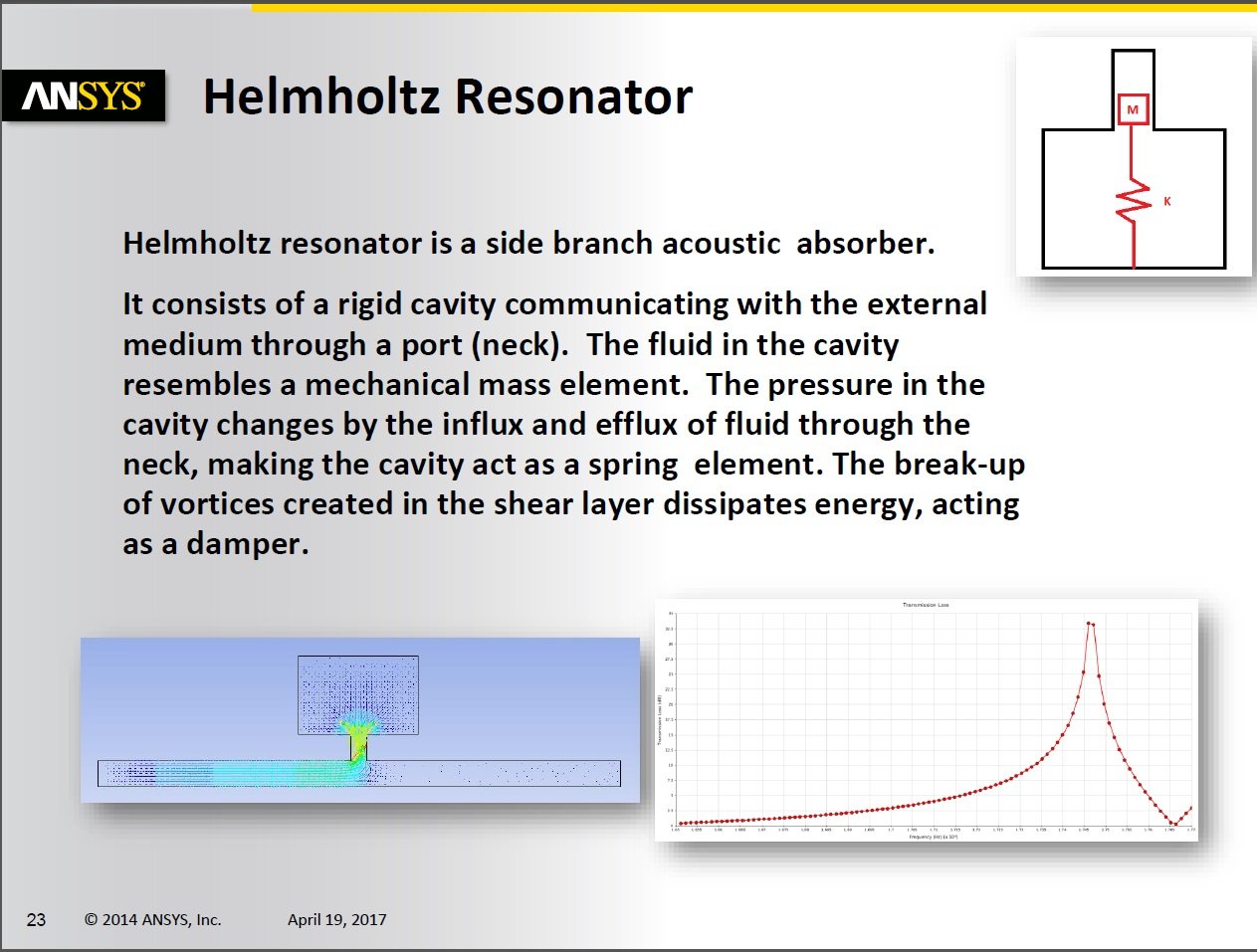-
-
December 12, 2017 at 10:34 am
emirdegirmenli
SubscriberI'm working on finding modes of the cavity, especially Helmholtz mode by using acoustics ACT. I designed a basic model and I got some results but they do not match results which I got using Helmholtz resonator formula (below). I found some document about Helmholtz resonator in Acoustics ACT docs but it is not detailed
To find Helmholtz resonance, I defined surface of the hole as a 101325 Pa for 1 ATM air pressure condition. but I am not sure if this approach is correct. Because, pressure travel through the neck and in the air. We know neck length but don't know the distance traveled in the air. (l attached SpaceClaim folder (18.0) of my model)
Best, Emir
maybe this model can be worked ??
-
December 14, 2017 at 9:38 pm
-
December 17, 2017 at 2:42 am
peteroznewman
SubscriberEmir,
I am gradually learning the ACT Acoustics Extension and worked most of the workshops that came with the documentation.
PIPE
I am reading “The Science of Sound” 2nd Edition by Thomas D. Rossing. Example 4.3 is to find the first three modes of vibration of a pipe 750 mm long with one open end and one closed end (neglect end correction). The answer in the book is f1 = v/4L = 343/4(0.75) = 114 Hz, f2 = 3(343)/4(0.75) = 343 Hz and f3 = 5(343)/4(0.75) = 572 Hz. These frequencies are calculated from knowing the standing wave patterns of the first three modes. I built a Modal Acoustics model in ANSYS 18.2 and got excellent agreement.
FLASK
Rossing provides a formula to calculate the frequency of a Helmholtz resonator in Section 2.3 and gives an example of a flask with a 980 mm diameter sphere, a 30 mm diameter neck that is 100 mm long.
Rossing formula f = 207 Hz
Acoustic model f = 232 Hz.
CYLINDER by Emir
Your formula f = 262 Hz
Acoustic model f = 299 Hz
Rossing formula f = 346 Hz
Rossing says that open pipes have an “end effect” that adds to the length of typically 0.61D, while the formula you gave seems to have an “end effect” correction of 0.75D. I find it interesting that if I zero out the end correction in your formula, I get the same value as the Rossing formula.
If I use a correction of 0.35D, then I get f = 298 Hz, which is very close to the acoustic model.
I hope some of this is useful for you.
Best regards,
Peter
-
December 20, 2017 at 7:56 am
emirdegirmenli
SubscriberThak you Peter, You researched very detailedly. Maybe we can define new hole length of the acoustic model by regarding "end effect" because we defined the end of the neck as a constant pressure (0 Mpa). Or we use original neck length and we define other body has compressible air condition for the open end. ? will test them, thank you again. Best, Emir
-
August 6, 2023 at 12:20 pm
Noora
SubscriberHello,
I have the same project related to helmholtz resonator and I’m new to Acoustics Extension. I did the same thing as “peteroznewman” did. 0.85 is suggested as a shape modifier in an article. when I assume shape modifier 0.35, I got close result to my simulation. But I don't what factor is correct.
-
September 13, 2023 at 4:50 am
gemma lyly
SubscriberThe resonator has a cavity or chamber that can be in the shape of a sphere, cylinder, or other geometric forms. This cavity is connected to an opening or neck. connections unlimited
-
- The topic ‘Helmholtz Resonator’ is closed to new replies.


Exploring the Power of HPC and Cloud Computing
Join us for this insightful webinar to discover how HPC and cloud computing unlocks the full potential of engineering simulation. Whether you are an engineer, IT manager, researcher, or technology enthusiast, this webinar provides the knowledge and tools to enhance your simulation workflows and drive innovation in your industry.

The Road to Innovation is Driven by Simulation
Join us for Driven by Simulation, an exciting new video series that shows how simulation enables the rapid innovation transforming the way we move — on the street, off-road, or at the track. Each episode celebrates breakthrough tech that’s paving the way for safer, faster, cleaner, more connected driving experiences.

Tensile Test Simulation Best Practices
It is fascinating to compare experimental and simulation test results for a tensile test specimen. The ability to conduct tests virtually, rather than physically, utilizing virtual simulations for testing not only increases efficiency but also leads to significant cost savings. In this crosstalk, we will address some of the challenges typically encountered in uniaxial tensile simulations.

Ansys Blog
Subscribe to the Ansys Blog to get great new content about the power of simulation delivered right to your email on a weekly basis. With content from Ansys experts, partners and customers you will learn about product development advances, thought leadership and trends and tips to better use Ansys tools. Sign up here.

- How to use ‘direct attachment’ in a revolute joint connection
- Analysis of Robotic Finger
- Shape Memory Alloy Simulation
- shell to solid connection with thermal load
- ANSYS Mechanical keeps crashing/not responding after mesh is complete
- Composite Pressure Vessel
- Large deflection convergence problem
- Questions about the Static/Quasi-Static/Dynamic
- About stresses in the elements
- V-bending problem using Transient Structural

-
1007297
-
494777
-
322391
-
262035
-
183856

© 2024 Copyright ANSYS, Inc. All rights reserved.


















